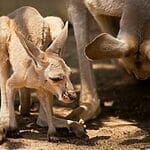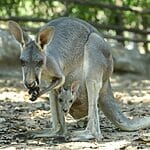We all love the cute joeys, the baby kangaroos that live in the mothers pouch. Many believe that they are born in the pouch but that is actually not the case.
Joeys will climb into the pouch independently following their birth. So that once again raises the question: how do kangaroos give birth (see also: Male Animals That Give Birth or Kangaroo Evolution)?

They will first move into the birthing position that allows the mother to clean the pouch and belly area for the arrival of the baby joey coming out of their birth canal.
From there the newborn joey will climb into the pouch where it will be able to feed from the mothers teets.
When initially born the joey is blind and without fur being just an inch tall and weighing only three ounces.
How Kangaroos Prepare To Birth
Kangaroos are usually prepared for the birth when it takes place. But what do they do to prepare themselves to birth their baby joey?
Their preparation will begin just a few hours before they give birth, a kangaroo about to give birth is easily recognizable by them constantly grooming themselves.
They will clear their pouch and the area that surrounds the opening of the birth canal.
The reason they clean this area so intensely is because the newborn requires a clean and protected environment for the first few months of its life to ensure that it does not get sick and also that it can support the joey as they grow.
Due to the kangaroo becoming more intense with the cleaning the closer it gets to the birth, this means that the kangaroo will lick the pouch and area around the birth canal to make sure it’s as clean as possible.
Then just a few minutes before giving birth the female kangaroo will assume the birthing position, if it is possible then the animal will be resting its back up against a tree and sit up on to its tail whilst slightly leaning back.
The Birthing Process

Kangaroos are mammals but being the largest marsupial on the planet they still give birth to their young after a very short period of gestation.
The baby joeys are not grown in a placenta like most mammal offspring, the pregnancy of a kangaroo is only around 28 days.
After developing in the womb for around a month the fetus will leave the uterus and be coated with the amnion that coats the birth canal.
During the birth the joey embryo is coated in this amnion to protect and nourish it, and once it is born the newborn will eat the yolk and once born it will be around the same size as a jellybean.
What Happens After Birth
Shortly after birth the joey faces a difficult task, the mother has helped to prepare her newborn for the next journey that it must undertake to stand any chance of surviving.
The mother has licked a thick trail of saliva from her cloaca up from her pouch to one of the four available nipples.
The journey is the joeys alone to make, the mother can not assist her child but the newborn is equipped with the perfect tools for the job.
The newborn’s arms are by far their most developed feature at this time and is enough to help it pull and crawl the way up to one of her nipples.
The newborn will make its way up through the mothers thick hair until it finds the nipple and then latches on, once the joey latches on the mothers nipple will inflate itself allowing the baby to feed and get the vital nutrients essential for it to begin growing into the adorable fluffy joey that we are all accustomed to.
It will continue being latched onto the nipple until the joey develops a jaw and is able to unlatch himself from his mother’s nipple.
Once the newborn is able to feed itself the mothers milk will change from the milk that is packed with high amounts of protein, water, carbohydrates and immunity free.
The milk that is produced by the mother can incredibly adapt to the stage of the newborn’s growth providing it with the necessary nutrients needed to facilitate its growth and development.
Kangaroos can also have more than one joey feeding at once, whilst not born at the same time the gestation period being so short there can be one than one joey feeding at once.
Incredibly the red kangaroo can facilitate both the newborn and a developing joey at once, it can mix the milks in each nipple providing both with the necessary nutrients that they require to grow.
Whilst in the pouch the joey will grow from its birth weight of one gram to around four kilograms when it leaves the pouch.
When the now more developed joey is only a few weeks away from leaving its mothers pouch only then will the joey begin to grow its fur until that point the joey is referred to as a ‘pinkie’ due to the animal’s bright pink skin.
It can take from six to nine months for the joey to be able to independently leave the mothers pouch.
The baby joey can suckle at the teat up until the age of two where it will then graze like other kangaroos.
They will still be dependent on their mother for a couple of years after leaving the pouch, but they leave early in their development to ensure that the pouch is free for the next newborn to develop.
Final Thoughts
So there you have it, all that you need to know about the fascinating phenomenon of a baby joeys development.
Marsupials are an often overlooked group of animals as they are not seen as cool as reptiles and birds or the other mammals like the big cats and wolves.
But despite this they are some of the unique animals and kangaroos are perhaps the unique of the bunch. Hopefully you have learnt a lot of new cool kangaroo facts.
- What Should I Do If A Koala Bites Me? Safety Guide - 2024-05-30
- Are Kangaroos Born Without Hind Legs? A Fascinating Journey - 2024-05-30
- Animals That Look Like Squirrels - 2024-05-30









